Research Progress of Nano Copper Lubricant Additives on Engineering Tribology
Abstract
1. Introduction
2. Characteristics of Nano-Copper Particles
3. Dispersion Stability of Nano-Copper Lubricant Additive
3.1. Surface Modification
3.2. Polymer Coating Methods
3.3. Mechanical Dispersion Methods
4. Tribological Development of Copper Composite Lubricants
5. Lubrication Mechanism of Nano-Copper as Additives
5.1. Forming Mechanism of Lubrication Film
5.2. Self-Repair Mechanism
5.3. Micro-Rolling Bearing Effect
5.4. Lubrication Theory and Simulation of Nanoparticle Lubricating Oil Additives
6. Conclusions and Prospect
Author Contributions
Funding
Institutional Review Board Statement
Informed Consent Statement
Data Availability Statement
Conflicts of Interest
References
- Zhang, Y.D.; Yan, J.S.; Sun, L.; Yang, G.B.; Zhang, Z.J.; Zhang, P.Y. Friction Reducing Anti-wear and Self-repairing Properties of Nano-Cu Additive in Lubricating Oil. Chin. J. Mech. Eng. 2010, 46, 74–79. [Google Scholar] [CrossRef]
- Fan, F.Q.; Zhang, C.Y.; Zhou, K.; Huang, Q.; Tang, Z.P.; Yu, Q.L.; Cal, M.R. Tribological properties of lubricating additives of phosphorus-based halogen-free oil-soluble ionic liquid. China Surf. Eng. 2020, 33, 136–143. [Google Scholar]
- Chen, J.; Wang, X.L.; Xu, B.S.; Xu, Y.; Zhang, G.Q. Tribological properties of regenerative diesel engine lubricating oil. Mater. Prot. 2012, 45, 27–29. [Google Scholar]
- Ali, I.; Basheer, A.A.; Kucherova, A.; Memetovd, N.; Paskod, T.; Ovchinnikov, K.; Pershind, V.; Kuznetsovf, D.; Galunind, E.; Grachevg, V.; et al. Advances in carbon nanomaterials as lubricants modifiers. J. Mol. Liq. 2019, 279, 251–266. [Google Scholar] [CrossRef]
- Zhang, C.H. Interaction between anti friction additive and surface. Surf. Technol. 2020, 49, 6–7. [Google Scholar]
- Li, J.S.; Hao, L.F.; Xu, X.H.; Zhang, L. Preparation and Tribological Properties of surface modified copper nanoparticles. China Surf. Eng. 2010, 23, 32–37. [Google Scholar]
- Wu, W.; Liu, J.; Li, Z.; Zhao, X.Y.; Liu, G.Q.; Liu, S.J.; Ma, S.H.; Li, W.M.; Liu, W.M. Surface- functionalized nanomofs in oil for friction and wear reduction and antioxidation. Chem. Eng. J. 2021, 410, 128306. [Google Scholar] [CrossRef]
- Kotia, A.; Chowdary, K.; Srivastava, I.; Ghosh, S.K.; Ali, M.K.A. Carbon nanomaterials as friction modifiers in automotive engines: Recent progress and perspectives. J. Mol. Liq. 2020, 310, 113200. [Google Scholar] [CrossRef]
- Nguyen, P.A.; Ai, V.; Dang-Bao, T.; Hong, P.P.; Nguyen, T. Green synthesis of copper nanoparticles using Cocoa pod extract and its catalytic activity in deep oxidation of aromatic hydrocarbons. SN Appl. Sci. 2020, 310, 1795. [Google Scholar] [CrossRef]
- Smirnov, V.M.; Shalunov, E.P. Antifriction powder bronzes with mechanically alloyed copper-based granules. IOP Conf. Ser. Mater. Sci. Eng. 2020, 709, 033030. [Google Scholar] [CrossRef]
- Cao, L.; Luo, B.; Gao, H.; Miao, M.; Deng, Y. Structure induced wide range wettability: Controlled surface of micro-nano/nano structured copper films for enhanced interface. J. Mater. Sci. Technol. 2021, 84, 147–158. [Google Scholar] [CrossRef]
- Rosenkranz, A.; Costa, H.; Baykara, M.Z.; Martini, A. Synergetic effects of surface texturing and solid lubricants to tailor friction and wear—A Review. Tribol. Int. 2020, 155, 106792. [Google Scholar] [CrossRef]
- Nagaraju, G.; Tharamani, C.N.; Chandrappa, G.T.; Livage, J. Hydrothermal synthesis of amorphous MoS2 nanofiber bundles via acidification of ammonium heptamolybdate tetrahydrate. Nanoscale Res. Lett. 2007, 2, 461. [Google Scholar] [CrossRef] [PubMed]
- Hwang, Y.; Park, H.S.; Lee, J.K.; Jung, W.H. Thermal Conductivity and Lubrication Characteristics of Nanofluids. Curr. Appl. Phys. 2006, 6, 67–71. [Google Scholar] [CrossRef]
- Shaon, F.; Rana, A.A.; Masum, S.M.; Ullah, M.A.; Karim, M.M. Surface-capped copper nanoadditive for improvement of base oil properties. Bangladesh J. Sci. Ind. Res. 2019, 54, 1–10. [Google Scholar] [CrossRef]
- Yang, H.J.; Tian, K.H.; Liu, C.L.; Ren, X.Y.; Deng, Y.J. Synthesis of stable and disperse copper nanoparticles colloids via solution chemical reduction. Mater. Rev. 2019, 54, 1–10. [Google Scholar]
- Han, S.X. Analysis and Optimization of Tribological Properties of Nano Copper Additive for Lubricating Grease. Master’s Thesis, Xi’an Technological University, Xi’an, China, 2016. [Google Scholar]
- Wang, Z.; Ren, R.; Song, H.J.; Jia, X. Improved tribological properties of the synthesized copper/carbon nanotube nanocomposites for rapeseed oil-based additives. Appl. Surf. Sci. 2018, 428, 630–639. [Google Scholar] [CrossRef]
- Zhang, X.M.; Zhang, Z.Z.; Lin, F.; Wen, Y.P.; Lei, X.X. Preparation of copper nano-particles and dispersion technics in alcohol. Mater. Eng. 2013, 1, 25–29. [Google Scholar] [CrossRef]
- Hosseini, S.R.; Ghasemi, S.; Ghasemi, S.A. Fabrication and Performance Evaluation of Pd-Cu Nanoparticles for Hydrogen Evolution Reaction. Chem. Sel. 2019, 4, 6854–6861. [Google Scholar] [CrossRef]
- Zhou, T.; Wang, Q.; Meng, Z. Suspension Stability and Tribological Performance of Nano-Copper in 460 Lubricating Oil. Mater. Prot. 2020, 53, 75–79. [Google Scholar]
- Shi, S.C.; Tsai, X.N.; Pek, S.S. Tribological behavior and energy dissipation of hybrid nanoparticle-reinforced HPMC composites during sliding wear. Surf. Coat. Technol. 2020, 389, 125617. [Google Scholar] [CrossRef]
- Mao, L.; Zhang, R.; Ke, X.; Pang, J. Comparison of dispersion properties between copper nano-particles and carbon coated copper nano-particles. China Powder Sci. Technol. 2010, 16, 50–54. [Google Scholar]
- Peter, C.K.; Andrew, J.P.; Susan, H.R.; Stefan, G.; Mahnaz, Z.J. Embedment of copper particles into polymers by cold spray. Surf. Coat. Technol. 2013, 216, 60–67. [Google Scholar]
- Ma, X.K.; Su, X.D.; Zhou, B.; Zhao, X.; Tian, Y.M.; Wang, Z.C. Synthesis and Friction Properties of Copper/PMMA Composites by Soapless Emulsion Polymerization. J. Appl. Polym. Sci. 2011, 122, 2837–2842. [Google Scholar] [CrossRef]
- Wang, Y.; Li, N.; Liu, H.; Wang, J.; Huang, J. Investigation on tribology behaviors of oil-soluble nano-cu lubricating additive for aluminum alloy ZL101. IOP Conf. Ser. Earth Environ. Sci. 2020, 513, 012017. [Google Scholar] [CrossRef]
- Dong, L.; Chen, G.X.; Fang, J.H. Tribological properties research of nanometer microcapsule copper. Synth. Lubr. 2004, 31, 1–3. [Google Scholar]
- Zhang, A.L.; Jin, H.; Li, Z.J.; Zhu, Y.M. Superficial polymer modification of nanocopper particles. J. Shenyang Univ. Technol. 2007, 29, 271–274. [Google Scholar]
- Yang, G.B.; Chai, S.T.; Xiong, X.J.; Zhang, S.M.; Yu, L.G.; Zhang, P.Y. Preparation and tribological properties of surface modified Cu nanoparticles. Trans. Nonferrous Met. Soc. China 2012, 22, 366–372. [Google Scholar] [CrossRef]
- Sun, S.M. Study of oil soluble nano-cu synthesis with liquid phase chemical reduction. Guangzhou Chem. Ind. 2012, 40, 40–42. [Google Scholar]
- Pan, Q.H.; Zhang, X.F. Synthesis and tribological behavior of oil-soluble cu nanoparticles as additive in SF15W/40 lubricating oil. Rare Met. Mater. Eng. 2010, 39, 1711–1714. [Google Scholar] [CrossRef]
- Yan, C.; Zhang, X.F.; Cheng, X.N. Preparation, characterization of oil-soluble copper nanoparticles and the tribological property as additive in SF15W/40 lubricating oil. Lubr. Eng. 2009, 45, 27–30. [Google Scholar]
- Chen, Y.; Renner, P.; Liang, H. Dispersion of nanoparticles in lubricating oil: A critical review. Lubricants 2019, 7, 7. [Google Scholar] [CrossRef]
- Ju, B.Y.; Song, Y.W.; Zhao, B.Y.; Jiang, Y.J.; Yang, W.P.; Wu, G.H. Process control and mechanical properties of graphene/Al composites based on flaky powder metallurgy. J. Aeronaut. Mater. 2021, 41, 45–52. [Google Scholar]
- Moldovanu, D.; Molea, A.; Barabás, I. Preliminary results on nano-diamond and nano-graphite testing as additive for an engine lubrication oil. IOP Conf. Ser. Mater. Sci. Eng. 2020, 724, 012047. [Google Scholar] [CrossRef]
- Li, X.; Zhang, D.; Xu, X.; Lee, K.R. Tailoring the nanostructure of graphene as oil-based additive: Toward synergistic lubrication with amorphous carbon film. ACS Appl. Mater. Interfaces 2020, 12, 43320–43330. [Google Scholar] [CrossRef] [PubMed]
- Guo, X.; Pu, M.; Yang, Z. Synthesis, Structure and tribological properties of graphene /LaF 3 composites as water-based lubricant additives. Tribology 2019, 39, 35–42. [Google Scholar]
- Jatti, V.S.; Singh, T.P. Copper oxide nano-particles as friction-reduction and anti-wear additives in lubricating oil. J. Mech. Sci. Technol. 2015, 29, 793–798. [Google Scholar] [CrossRef]
- Wang, L.P.; Zhang, C.L.; Zhang, P.; Xiong, Q.J.; Xu, J.B.; Jin, L.L.; Jin, Z.J. Comparison of otherness on fuel economy measurement methods for gasoline engine oil. Lubr. Oil 2019, 34, 14–17. [Google Scholar]
- Singh, Y.; Sharma, A.; Singh, N.K.; Chen, W.H. Development of bio-based lubricant from modified desert date oil (balanites aegyptiaca) with copper nanoparticles addition and their tribological analysis. Fuel 2020, 259, 1–12. [Google Scholar] [CrossRef]
- Jiang, Z.C.; Fang, J.H.; Liu, P. Tribological properties and mechanism of lubricating oils containing nano-copper under current-carrying conditions. Lubr. Eng. 2021, 6, 10–16. [Google Scholar]
- Gondolini, A.; Mercadelli, E.; Zin, V.; Barison, S.; Sanson, A. Easy preparation method of stable copper-based nanoparticle suspensions in lubricant engine oil. Lubr. Sci. 2020, 32, 205–217. [Google Scholar] [CrossRef]
- Zhao, J.H.; Yang, G.B.; Zhang, C.L.; Zhang, Y.J.; Zhang, S.M.; Zhang, P.Y. Synthesis of water-soluble Cu nanoparticles and evaluation of their tribological properties and thermal conductivity as a water-based additive. Friction 2019, 7, 246–259. [Google Scholar] [CrossRef]
- Wang, Y.; Xin, L.; Yang, K.P.; Zhang, C.L.; Zhang, S.M.; Zhang, P.Y. Preparation and tribological properties of water-soluble copper nanoparticles modified with poly(ethylene glycol) xanthate. Lubr. Eng. 2018, 43, 83–89. [Google Scholar]
- Wang, Q.; Wang, L.; Zhao, S.L.; Meng, Z. Experimental study on the suspension stability and tribological properties of nano-copper in LCKD-320 # lubricating oil. Appl. Nanosci. 2021, 11, 45–54. [Google Scholar]
- Sun, Y.Z.; Wang, Q.; Meng, Z. Suspension stability and tribological performance of nano-copper in 220~# lubricating oil. Hydrometall. China 2019, 38, 505–510. [Google Scholar]
- Zin, V.; Agresti, F.; Barison, S.; Colla, L.; Gondolini, A.; Fabrizio, M. The Synthesis and Effect of Copper Nanoparticles on the Tribological Properties of Lubricant Oils. IEEE Trans. Nanotechnol. 2013, 12, 751–759. [Google Scholar] [CrossRef]
- Luo, J.H.; Yu, N.; Cheng, M.; Cheng, M.L.; Yao, W.; Xu, J.G. Synthesis of novel macromolecular coupling agent and its application in nano-copper lubricating oil. Curr. Nanosci. 2019, 16, 253–258. [Google Scholar] [CrossRef]
- Yue, P.; Zhang, Y.J.; Zhang, P.Y.; Zhang, S.M. Research Progress of nanomaterials as lubricant oil additives. Surf. Technol. 2020, 49, 19–34. [Google Scholar]
- Liu, W.M.; Xue, Q.J.; Zhou, J.F.; Zhang, Z.J. Study on the anti-wear effect of nanoparticles and its application as wear repair additive. China Surf. Eng. 2001, 14, 21–23. [Google Scholar]
- Zhang, Y.J.; Zhang, S.M.; Sun, D.; Yang, G.B.; Gao, C.P.; Zhou, C.H.; Zhang, C.L.; Zhang, P.Y. Wide adaptability of Cu nano-additives to the hardness and composition of DLC coatings in DLC/PAO solid-liquid composite lubricating system. Tribol. Int. 2019, 138, 184–195. [Google Scholar] [CrossRef]
- Zhang, Y.D.; Yan, J.S.; Yu, L.G.; Zhang, P.Y. Effect of nano-Cu lubrication additive on the contact fatigue behavior of steel. Tribol. Lett. 2010, 37, 203–207. [Google Scholar] [CrossRef]
- Borda, F.L.; Oliveira, S.J.; Lazaro, L.; Leiroz, A.J. Experimental investigation of the tribological behavior of lubricants with additive containing copper nanoparticles. Tribol. Int. 2018, 117, 52–58. [Google Scholar] [CrossRef]
- Tepper, S. Study of friction reduction by nanocopper additives to motor oil. Wear 2002, 252, 63–69. [Google Scholar]
- Jiang, Z.W.; Hu, C.Y.; Shi, Y.; Zhang, C. Migration of copper from nano-copper/polypropylene composite films and its effects on the properties of films. Food Ferment. Ind. 2019, 22, 100416. [Google Scholar]
- Shi, Y.J.; Wrona, M.; Hu, C.Y.; Nerin, C. Copper release from nano-copper/polypropylene composite films to food and the forms of copper in food simulants. Innov. Food Sci. Emerg. Technol. 2021, 67, 102581. [Google Scholar] [CrossRef]
- Zhang, M.; Wang, X.B.; Fu, X.S.; Liu, W.M. Self repairing behavior and mechanism of oil soluble nano Cu under fretting wear. J. Tribol. 2005, 25, 504–509. [Google Scholar]
- Yang, F.; Xia, X.L.; Xu, C. Self- repairing mechanism and tribological properties of nano-Cu as lubricating oil additives. Mater. Prot. 2018, 51, 22–25. [Google Scholar]
- Ye, F.X.; Sun, X. Nanoindentation response analysis of TiN-Cu coating deposited by magnetron sputtering. Prog. Nat. Sci. Mater. Int. 2018, 28, 40–44. [Google Scholar] [CrossRef]
- Liu, G.; Li, X.; Qin, B.; Xing, D.; Guo, Y.; Fan, R. Investigation of the mending effect and mechanism of copper nano-particles on a tribologically stressed surface. Tribol. Lett. 2004, 17, 961–966. [Google Scholar] [CrossRef]
- Ali, M.; Hou, X.J.; Abdelkareem, M.A.A. Anti-wear properties evaluation of frictional sliding interfaces in automobile engines lubricated by copper/graphene nanolubricants. Friction 2020, 8, 905–916. [Google Scholar] [CrossRef]
- Mori, S. Boundary lubrication from the viewpoint of surface chemistry: Role of nascent surface on tribochemical reaction of lubricant additives. JTEKT Eng. J. 2010, 1008, 2–12. [Google Scholar]
- Zhou, P.A. Functional characteristics and application prospects of metal wear self repairing materials. China Surf. Eng. 2004, 17, 39–41. [Google Scholar]
- Shi, P.J.; Yu, H.L.; Wang, H.M.; Xu, B.S. Tribological behaviour of surface modified copper nanoparticles as lubricating additives. Phys. Procedia. 2013, 50, 461–465. [Google Scholar] [CrossRef][Green Version]
- Chen, W.C.; Cheng, J.G.; Chen, H.P. Nanosized copper powders prepared by gel-casting method and their application in lubricating oil. China J. Nonferrous Met. 2018, 28, 1186–1191. [Google Scholar] [CrossRef]
- Wang, X.L.; Xu, B.S.; Xu, Y.; Shi, P.J.; Yu, H.L.; Zhao, Y. Application of nano copper additive in equipment repair technology. China Surf. Eng. 2006, 34, 134–136. [Google Scholar]
- Wang, J.; Guo, X.; Mi, H. Effect of nano-coppers with different dimensions on tribological properties of lithium grease. China Pet. Process. Petrochem. Technol. 2020, 22, 118–126. [Google Scholar]
- Tevet, O.; Von-Huth, P.; Popovitz-Biro, R.; Rosentsveig, R.; Wangner, H.D.; Tenne, R. Friction mechanism of individual multilayered nanoparticles. Proc. Natl. Acad. Sci. USA 2011, 108, 19901–19906. [Google Scholar] [CrossRef]
- Chen, Z.; Liu, X.; Liu, Y.; Gunsel, S.; Luo, J. Ultrathin MoS2 nanosheets with superior extreme pressure property as boundary lubricants. Sci. Rep. 2015, 5, 12869. [Google Scholar] [CrossRef]
- Wu, H.; Yin, S.; Du, Y.; Wang, L.; Wang, H. An investigation on the lubrication effectiveness of MoS2 and BN layered materials as oil additives using block-on-ring tests. Tribol. Int. 2020, 151, 106516. [Google Scholar] [CrossRef]
- Spikes, H. Friction modifier additives. Tribol. Lett. 2015, 60, 1–26. [Google Scholar] [CrossRef]
- Xia, Y.Q.; Chen, C. Tribological properties of serpentine powder/soft metal nanoparticles as complex lithium-based grease additive petroleum. Process. Petrochem. 2020, 51, 58–62. [Google Scholar]
- Igor, U.E.; Vladimir, A.Z.; Victoria, E.B. Metal-containing nanomaterials as lubricant additives: State-of-the-art and future development. Friction 2019, 7, 93–116. [Google Scholar]
- He, Q.; Li, A.L.; Zhang, Y.M.; Liu, S.F.; Guo, Y.C. Experimental study of tribological properties of lithium-based grease with Cu nanoparticle additive. Tribol. Mater. Surf. Interfaces 2017, 11, 1–8. [Google Scholar]
- Zhang, L.; Hong, G.; Cai, S. Molecular dynamics simulation of aggregation of monocrystal and polycrystal copper nanoparticles. Int. J. Mod. Phys. B 2019, 33, 1950168. [Google Scholar] [CrossRef]
- Chen, C.S.; Cian, H.J.; Yu, C.H.; Huang, C.W. Friction coefficient calculation and mechanism analysis for MoS2 nanoparticle from molecular dynamics simulation. Procedia Eng. 2014, 79, 617–621. [Google Scholar] [CrossRef][Green Version]
- Leng, Y.F.; Liu, Y.U.; Li, Q. Molecular dynamics simulation of the mechanism of increasing thermal conductivity of ricinoleic acid by nano copper. Lubr. Eng. 2021, 46, 68–73. [Google Scholar]
- Wu, H.; Qin, L.; Dong, G.; Hua, M.; Yang, S.; Zhang, J. An investigation on the lubrication mechanism of MoS2 nano sheet in point contact: The manner of particle entering the contact area. Tribol. Int. 2017, 107, 48–55. [Google Scholar] [CrossRef]
- Wu, H.; Johnson, B.; Wang, L.; Dong, G.; Yang, S.; Zhang, J. High-efficiency preparation of oil-dispersible MoS2 nanosheets with superior anti-wear property in ultralow concentration. J. Nanopart. Res. 2017, 19, 339. [Google Scholar] [CrossRef]
- Zhou, Z.; Xia, Y.; Ge, X. Synergistic Effects of MoDTC and Overbased Calcium Sulfonate Additive. Adv. Mater. Res. 2013, 651, 73–76. [Google Scholar] [CrossRef]
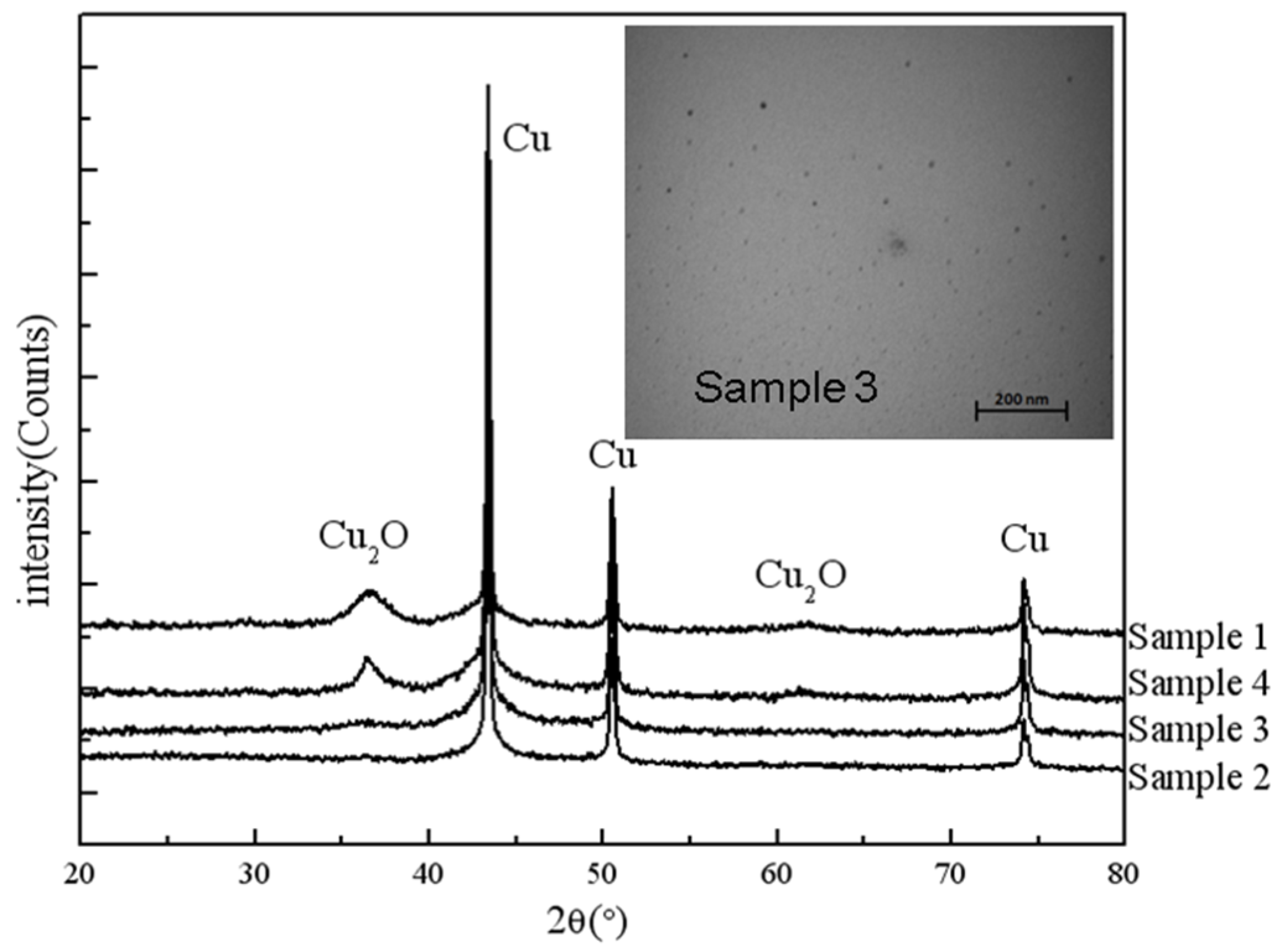

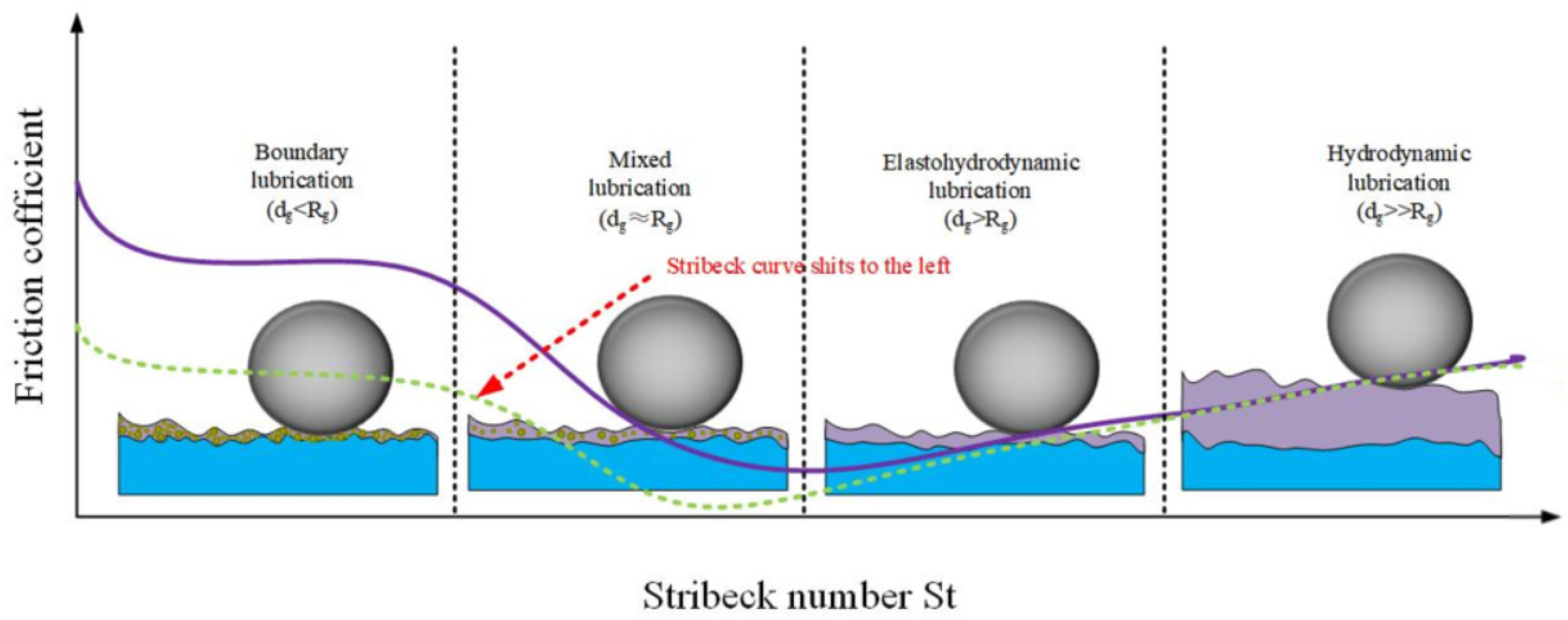
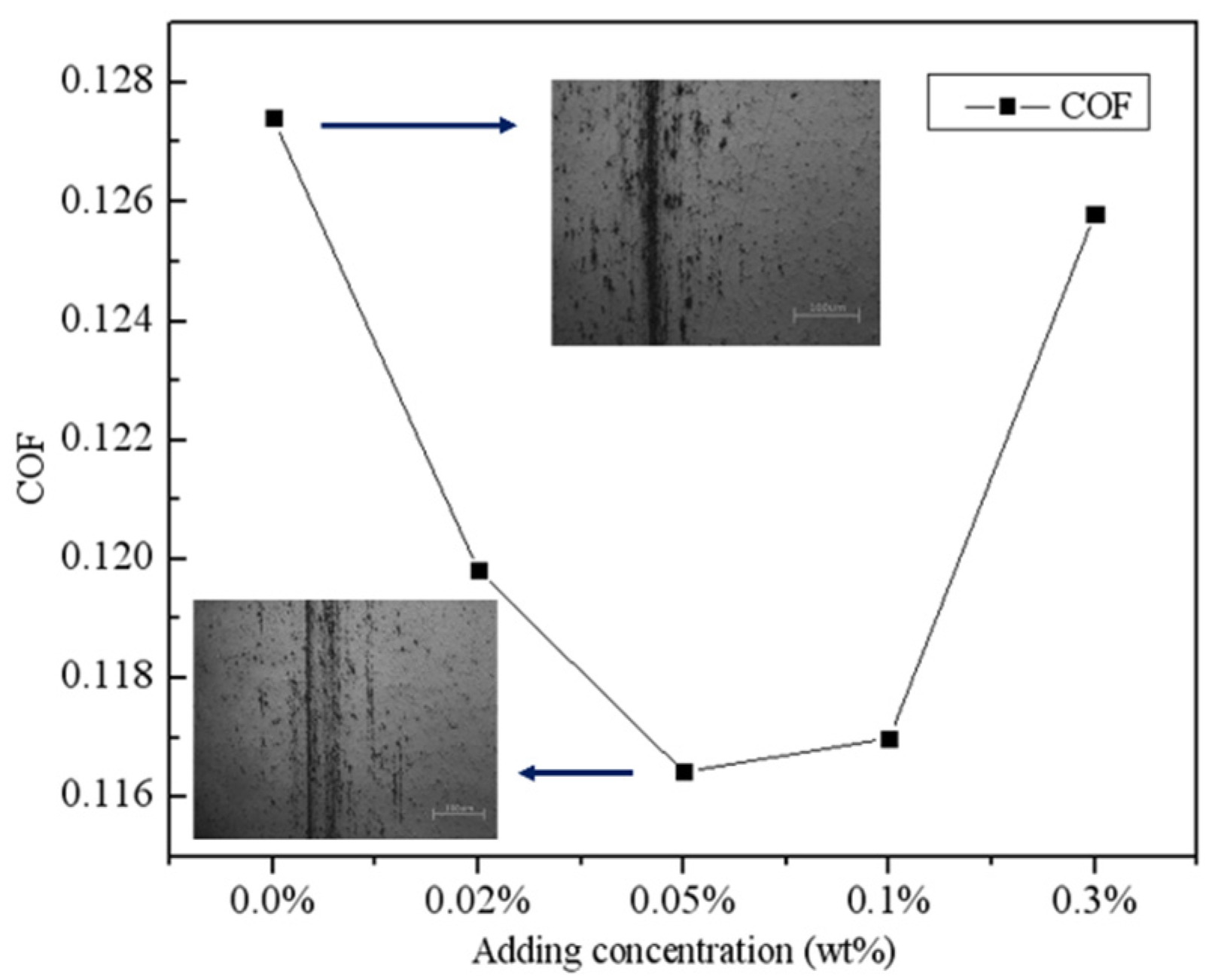
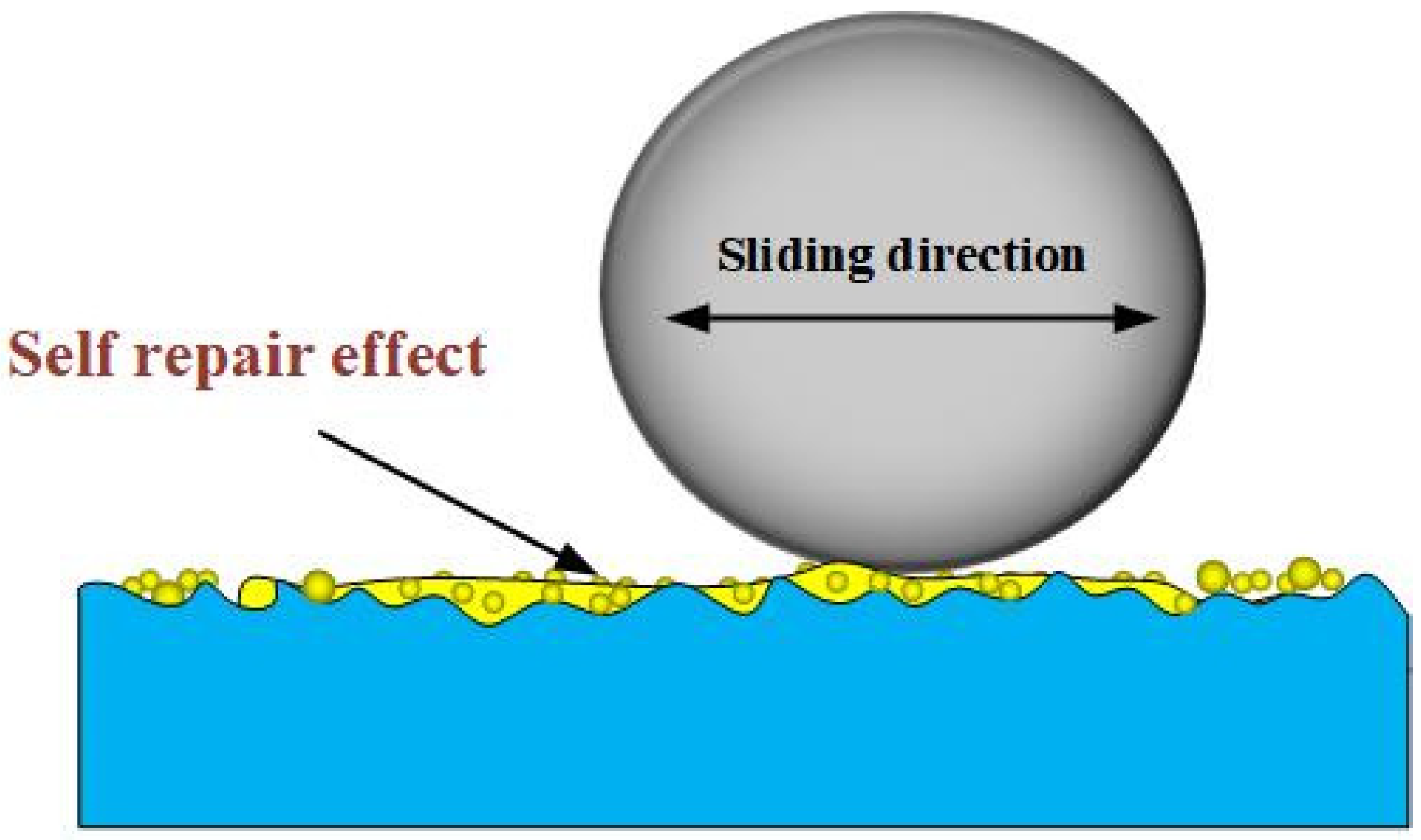

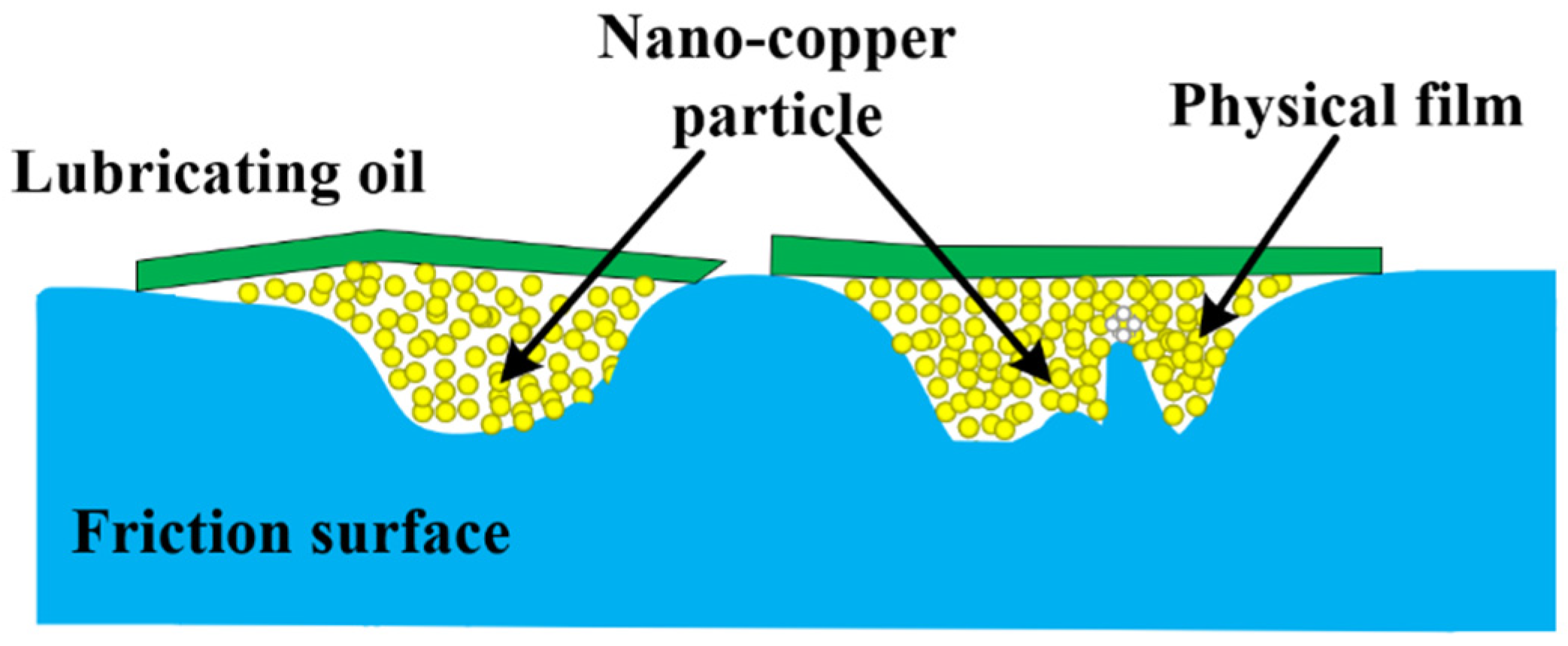
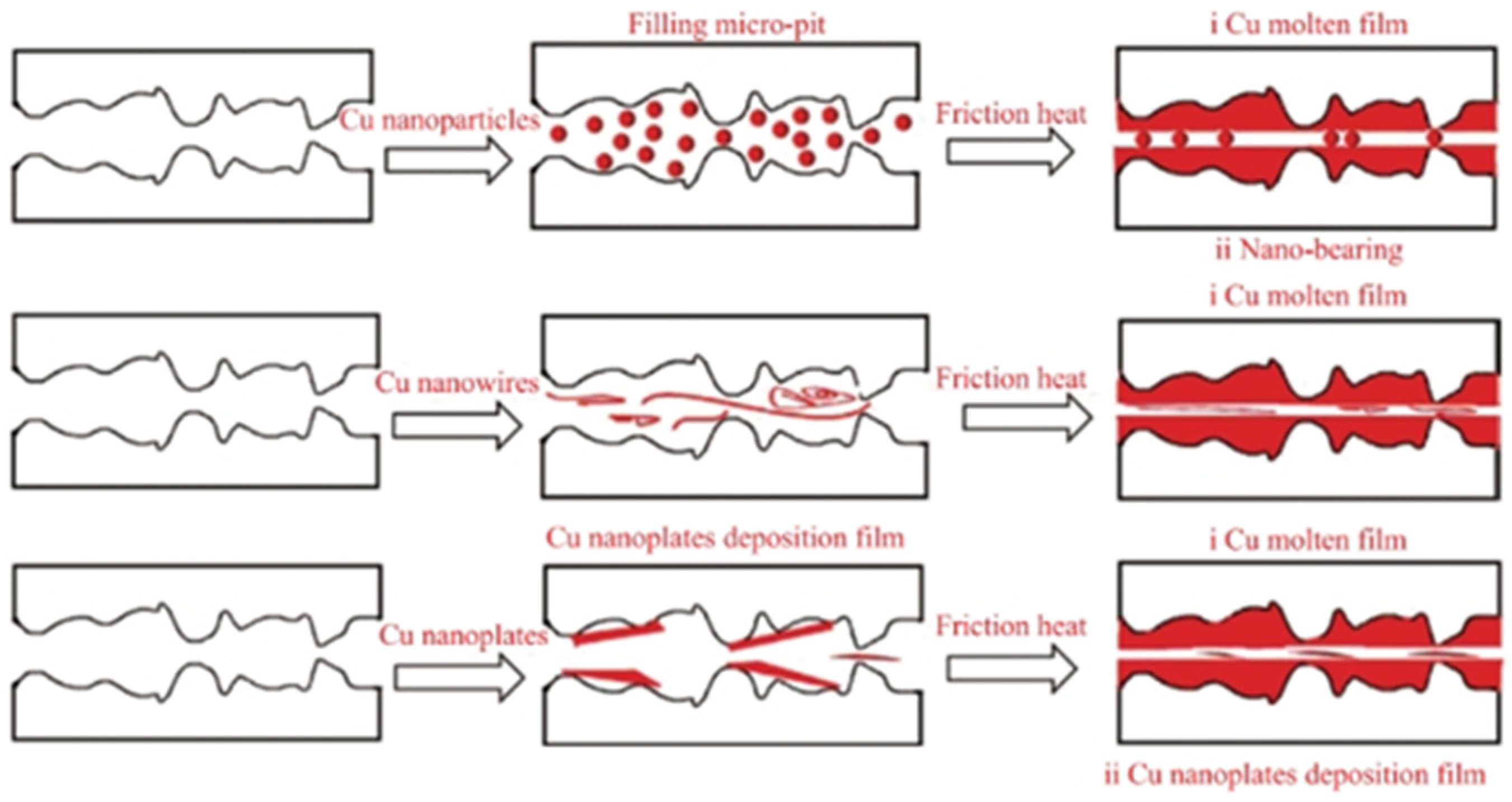
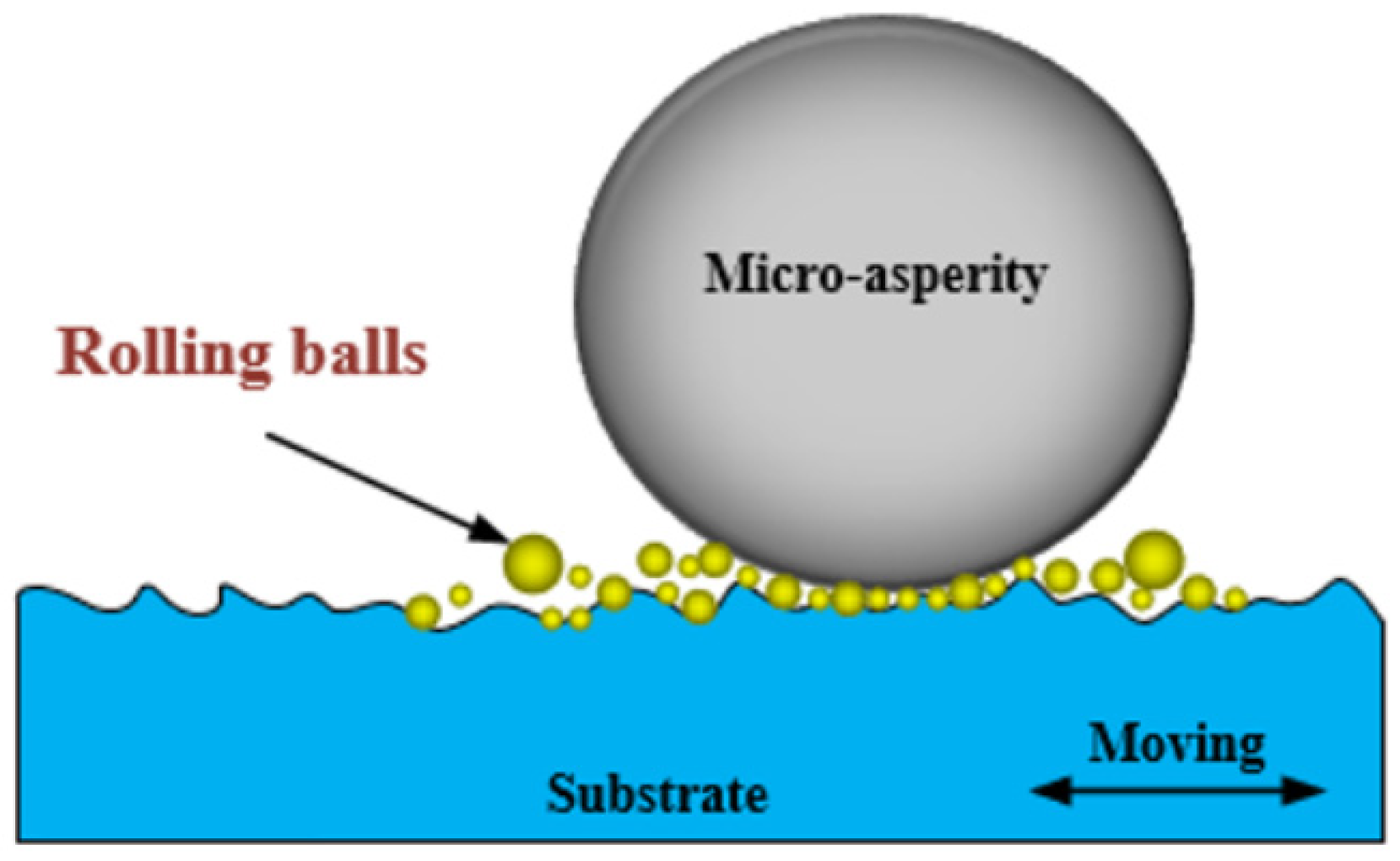
Publisher’s Note: MDPI stays neutral with regard to jurisdictional claims in published maps and institutional affiliations. |
© 2021 by the authors. Licensee MDPI, Basel, Switzerland. This article is an open access article distributed under the terms and conditions of the Creative Commons Attribution (CC BY) license (https://creativecommons.org/licenses/by/4.0/).
Share and Cite
Guo, J.; Zhao, Y.; Sun, B.; Wang, P.; Wang, Z.; Dong, H. Research Progress of Nano Copper Lubricant Additives on Engineering Tribology. Metals 2021, 11, 2006. https://doi.org/10.3390/met11122006
Guo J, Zhao Y, Sun B, Wang P, Wang Z, Dong H. Research Progress of Nano Copper Lubricant Additives on Engineering Tribology. Metals. 2021; 11(12):2006. https://doi.org/10.3390/met11122006
Chicago/Turabian StyleGuo, Junde, Yingxiang Zhao, Biao Sun, Puchao Wang, Zhijie Wang, and Hao Dong. 2021. "Research Progress of Nano Copper Lubricant Additives on Engineering Tribology" Metals 11, no. 12: 2006. https://doi.org/10.3390/met11122006
APA StyleGuo, J., Zhao, Y., Sun, B., Wang, P., Wang, Z., & Dong, H. (2021). Research Progress of Nano Copper Lubricant Additives on Engineering Tribology. Metals, 11(12), 2006. https://doi.org/10.3390/met11122006




